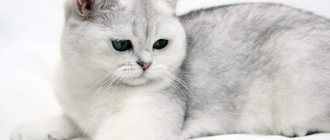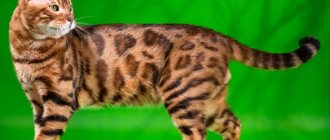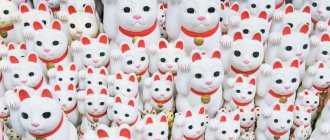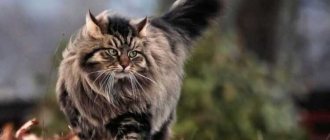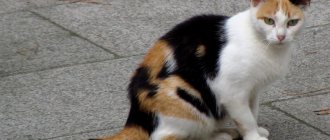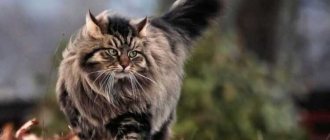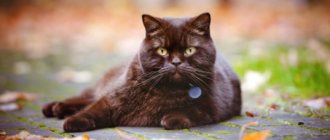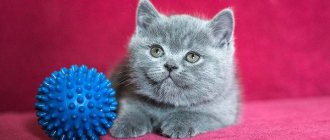The British are the aristocrats of the cat world. Looking at them brings incredible aesthetic pleasure. If you desperately want a cat that will add comfort and warmth to your home, but are afraid that you won't have enough time for a pet, the British is the right breed.
British cream cat
Beautiful, or better yet, luxurious, independent and charming animals with a calm disposition. What's the catch? It would be a lie to say that there is none. Before purchasing a plush kitten, it is better to learn in more detail some points about the character of the British. Then, if you decide that such a pet is ideal for your temperament, do some research on hereditary diseases in the British.
The British cat breed is exactly the option when the miser pays twice. Advertising sites are full of inexpensive kittens. On the other hand, the price for a kitten from a nursery can reach 15-50 thousand rubles. Where does such a range of prices come from and is there any point in overpaying? You need to figure this out on your own. After all, breeders of any price category have their own selfish interest - to sell kittens, so all their words and statements must be considered from a critical point of view.
Author of the article: Olga Shiltsova, practicing veterinarian, author of the books “Dachshund of Fate” and “Tails of Fortune”
History of the origin of the British cat
Judging by the name itself, it becomes clear that the homeland of these cats is Great Britain. Historians suggest that these animals were brought to the British Isles by the ancient Romans around the first century AD.
The main advantage of those ancient representatives of the British was their short and very dense coat, which provided the animals with protection from moisture and harmful insects. It was thanks to this wool that the British quickly got used to and adapted to new living conditions.
They were excellent hunters, thanks to their high levels of endurance and well-developed physical fitness.
Due to their spectacular appearance, at the end of the 16th century, British felines began to be looked at not only as skilled hunters. And already in 1871, British individuals participated in the first cat exhibition in London.
Diseases and health problems
The health of British Shorthair cats is quite good. Proper care and timely vaccination almost completely eliminate the likelihood of diseases. However, some dangers still await animals.
The most common health problems in the UK include:
- Obesity. This disease is associated with the natural large body of animals and their constant desire to eat. Excess weight can occur due to a violation of the pet’s diet, as well as an increase in the daily norm. At the same time, you cannot starve the animal - this can lead to a decrease in activity and loss of natural fluffiness;
- Hypertrophic cardiomyopathy. A hereditary disease, the detection of which dooms the animal to the absence of offspring (transmission of the disease is unacceptable). HCM occurs in adult cats (under 8 years of age) and cannot be treated. Annual cardiac ultrasounds and strict monitoring by a veterinarian help maintain the animal’s condition;
- Conjunctivitis. This disease occurs quite often. Its main symptoms are watery/festering eyes, and its prerequisites are injuries, infections or lack of vitamins. The disease is not fatal and can be treated fairly quickly;
- Gastritis. Inflammation of the stomach may be associated with an incorrectly composed diet of the animal. With such an illness, the cat may vomit, diarrhea and lead an inactive lifestyle;
- Parasites. Foreign living creatures affect not only the animal’s fur, but also its ears, eyes, and gastrointestinal tract. Among parasitic diseases, the most common are helminthiasis, demodicosis, and otodectosis. Regular deworming is used as a preventive measure.
Most (non-genetic) diseases are easily identified and quickly treated. The first signs of a cat's health problems are: lack of appetite, inactivity, vomiting, diarrhea, changes in the structure of the coat. Any of these signs should be a reason to visit a doctor. With timely examination and a correctly prescribed course of treatment, complications can be avoided.
Description of the breed
The main characteristic feature of the British is power, especially when it comes to males.
Female cats are smaller in size than male cats. Squat height and rather large size, developed muscles and sternum - this is the image of a modern Briton. The head of these cats is large with rounded outlines. The muzzle has developed cheeks and cheekbones. Only the British have a pronounced fold of skin around the neck.
The nose is medium long, rather wide. When viewed in profile, you can see that the nose forms a depression in the frontal part. The ears are located quite widely, with a wide base. The shape is rounded, the size of the ears is medium.
British people have large, round eyes. Set wide apart. What distinguishes British cats is the color of their eyes, characteristic of the breed - it is bright orange.
Newborns may have blue eyes, however, over time they will change their color. It is very rare to come across cats with blue or green eyes.
Medium or short llamas are equipped with well-developed strong muscles. The tail is of medium length and looks proportional to the body.
Color point colors
Color introduced into the breed by breeders. Sometimes it is also called “Siamese” or “Himalayan”. It has a rich palette of shades. According to the standard, a light body without spots and darkened legs, head, and tail. Wool with white undercoat. The eyes are blue, from watery-transparent to sapphire, bright blue, which is especially appreciated.
British pointing kittens are born almost white, with dark fur growing into adolescence, or even later. Over the years, both light and darker coats darken.
Black point (classic, seal point)
The most common color. On the body, the fur coat can range from white to almost chocolate color; the point markings are dark brown, turning into black. The nose and paw pads are black or black-brown.
Chocolate point
Rare beautiful color, one of the brightest. The cat's body is creamy in color, and the point markings are a rich chocolate color, which should be even and bright. The nose and paw pads are brown, maybe with a pinkish tint.
Blue point
Delicate, soft color. Cold tone. Gray-blue body and blue point markings. Looks very harmonious with ice blue eyes. The nose and paw pads are gray.
Lilac point
In this color there should be no sharp boundaries between the main color (white or almost white with a pinkish tint) and the gray-pink point markings. However, the difference in tones should be clearly visible. The nose and paw pads are gray-pink.
Red point
Quite a rare color. White or with a reddish tint coat, bright red point spots. The brighter the red, the better. Ideally, brick red color. The nose and paw pads are red to coral.
Cream point
Delicate creamy body color and smooth, easy transition to creamy point markings. The brightest spots are pink or coral nose and paw pads, as well as blue eyes.
Color point tortoises
A combination of two colors: color point and tortoiseshell. Delicate interesting color. Light body and spotted, mosaic markings. Point marks may contain a combination of any colors from the palette; soft, pastel colors are valued. The nose and paw pads match the base color.
Smoky color point
An interesting miracle of nature, or rather, the result of the work of breeders. Cats are carriers of two colors. The body can be any of the "smoke" colors: black smoke, blue smoke, lilac smoke, chocolate smoke, red smoke, cinnamon and fawn. Point markings are the same color, but darker. The undercoat is white, the nose and paw pads match the color.
Veiled color point
There are two types: on silver and on gold. On a silver-white or peach undercoat. Tipping on the back colors 1/8 of the hair in the tone of one color or another, point spots of the same color: black, blue, lilac, chocolate, red, cream, cinnamon and fawn. The nose and paw pads match the color.
Shaded color point
There are two types: on silver and on gold. On a silver-white or peach undercoat. Tipping on the back colors 1/3 of the hair to match the color of a particular color; point marks without sharp boundaries can be small. Black, blue, lilac, chocolate, red, cream, cinnamon and fawn. The nose and paw pads match the color.
Color point bicolor
Consists of two colors: white and any of the palette with point marks. As a rule, the chest, part of the body, the front legs are white, and there are also white spots on the cheeks. The symmetry of white spots and their harmonious arrangement are appreciated. Markings include black, blue, lilac, chocolate, red, cream, cinnamon and fawn. The nose and paw pads match the base color.
Fawn point
Light sandy body and light brown and beige markings. Exactly the deer shade, without the redness. Beige nose, beige paw pads.
Cinnamon Point
A very rare color, a breeders dream. Ivory coat and red-brown pointing markings. Red and pink-brown nose and paw pads.
Animal mating
Representatives of this breed belong to individuals with a late indicator of the development of reproductive systems.
Therefore, knitting a cat in its first year of life is strictly prohibited, because the animal may simply die. The body completes full development only by the age of 6 years.
Early mating of males before 2 years of age can lead to exhaustion, so in the future they will not be able to produce offspring.
British kittens are born completely similar to adults. Physiological features in the form of a disproportionate body are the norm for kittens. Over time, everything will return to normal, and the kitten will take on the appearance of a standard British cat.
Oriental cat - history of the breed, modern standards, character, care, nutrition + 83 photos- Maine Coon - history of occurrence, description of the breed, character + 84 photos
- Burma - a cat as a mascot, hygiene and health, character of the breed + 96 photos
Hereditary diseases: what you need to know about British health
The incredible popularity of the breed led to sad consequences. People simply bred their British cats with anyone, knowing that there would still be a queue for the kittens. It’s easy to sell such “British” dogs without documents, but 5 times cheaper than from the breeder. And buyers are happy - after all, they don’t want a cat for exhibition, but for the soul.
British kitten, silver tabby color
As a result, the British were bred with the Scots, animals with obvious defects such as too flat a nose were allowed to breed, and producers who brought kittens with congenital diseases were not culled. All this has led to the fact that the once healthy cat breed is considered one of the most problematic among veterinarians. “What did you want, you have a Briton,” - this phrase can easily be heard in a veterinary clinic. Before you run for a kitten “from an advertisement” or look for a mate for your “sort of British” cat, you need to study information about these diseases:
- Blood type incompatibility.
Like humans, cats have different blood types: A, B and AB (the latter is very rare). The blood type greatly depends on the breed of the pet. For example, all Siamese have blood type A. British cats have a problem: part of the population has blood type A, but 30-60% have blood type B. If animals with different blood types are bred, serious problems can arise in the kittens.
British cats are caring mothers
If the blood type of the mother and fetus do not match, pregnancy and childbirth proceed absolutely normally. But then the kittens suddenly die without showing any symptoms of illness. Sometimes they can survive for several days, their urine will be brown in color. The reason is that through their mother's milk they receive antibodies that destroy their blood cells. Anemia and kidney failure lead to the death of kittens.
Preventing the problem is simple: if a cat has blood type A, it is bred with cats that have blood type A. If a cat has blood type B, it is necessary to select a partner with blood type B.
Do careless breeders think about this? Hardly. In professional nurseries? Yes.
- Polycystic kidney disease.
Persian cats, who actively participated in the development of the British breed, gave it a terrible hereditary disease - polycystic kidney disease. If a cat was given a defective gene at birth, then regardless of the living conditions, it develops kidney failure. Such animals live from 3 to 10 years and require constant treatment.
There are genetic tests that must be carried out for breeding animals. Cysts can be detected on ultrasound from 3 months of age and later. The older the cat, the more obvious the changes in the kidneys become.
British tortoiseshell
- Heart disease.
The real killer of British and Scottish cats is hypertrophic cardiomyopathy (HCM). With a hereditary defect, the wall of the heart thickens and the chamber becomes smaller, and the heart cannot pump blood properly. With HCM, a seemingly healthy cat can die suddenly at a young age.
All Britons need to have a heart ultrasound scan called echocardiography. Usually, owners find out about this before castration of the pet or other surgical operation: anesthesia provokes the manifestation of the disease. But British cats involved in breeding need to be examined before the first mating, even if there are no signs of disease. Usually an ECHO is done upon reaching 1 year of age.
Young British silver tabby (Whiskas)
- Atresia of the lacrimal punctum.
Normally, the tear that washes the eye goes into the nasal cavity through a special channel. In the absence of the lacrimal punctum or its occlusion, constant lacrimation is observed. Animals with this problem can be easily identified by the brown trails that extend from their eyes. Lacrimal punctal atresia is a problem that runs in families, so Britons with this condition should never be bred. Treatment is only surgical.
This problem is more common in British cats of the “extreme type”, with an excessively shortened muzzle, like the Persian.
Classic British: the muzzle should not be flat and the nose should not be depressed
If you buy a British dog that is free from all genetic defects, then you can hope that the pet will delight you with excellent health for many years. Cats of this breed are somewhat prone to obesity due to their calm temperament, but this problem can be easily solved with proper feeding.
Character of the breed
The description of the character of the British cat says that these animals are suitable for people who spend little time within the walls of the house. These felines can cope just fine without human attention.
The British have a calm, aristocratic disposition. Even from the photo of a British cat it is clear that they know their worth and have a sense of unsurpassed dignity.
Along with this, they are very friendly and not aggressive. If they are often offended, they become withdrawn and unsociable.
If there is a child in the house, then such a cat will not be suitable for him as a fluffy toy. Otherwise, she will simply hide. British individuals get along well with other animals.
Kitten 1 month
The period of appearance of bear-type kittens. Month-old kittens are formed unevenly; a large body on short thick legs reminds us of a small bear. They sleep 16–20 hours, are very active, and play a lot.
4 weeks
Month-old kittens drink water on their own for 4 weeks, many eat wet and dry food themselves, and go to the litter box. Time to work with the kitten and adapt to the hands, teaching manners. The “change of color” of the eyes from blue to orange (for blue color), this happens gradually.
1 month
5 – 6 weeks | After 1.5 months, the kitten licks its fur and washes itself, the undercoat thickens, and the color becomes brighter.
5 weeks
At 7–8 weeks, babies are still drinking their mother’s milk and learning cat wisdom from her. The eyes acquired their color, became bright and clear.
1.5 months
Photo of a British cat
How to purchase
You can buy a British Blue cat either from official representatives or from other sellers, on sites such as Avito and others. The price of a British Blue cat ranges from 10 to 50,000 rubles.
If you are looking for a Premium class cat (for breeding), then buy the animal only from officials (kennels, breeders, etc.). Having documents about past diseases and vaccinations, as well as about the animal’s offspring, will allow you not to make a mistake when choosing.
We remind you that when purchasing you should pay attention to the following:
- The coat should be smooth, without matted lumps;
- There should be no wounds or pustules on the skin;
- The eyes are healthy and not watery.
British silver tabby color: types of color
British tabbies (British silver tabby) can be of the following types:
- blue silver striped BRI as 23;
- lilac silver striped BRI cs 23;
- chocolate silver striped BRI bs 23;
- cinnamon silver striped BRI os 23;
- fawn silver striped BRI ps 23;
- red silver striped BRI ds 23;
- cream silver striped BRI es 23;
- tortoiseshell silver striped BRI 23;
- bicolor silver striped BRI 23;
- silver color-point striped BRI 23;
- mixed colors (striped bicolor, striped tortoiseshell, striped tortoisebicolor, etc.).
